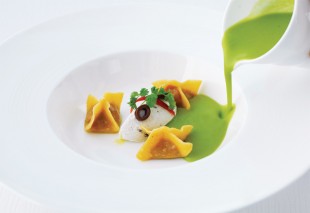

Cuisine focus: Italian

Meet the Experts
- Monica Sanchez, head chef, La Spiga by Papermoon, W Doha
- Claudio Melis, Italian executive chef, Alta Badia, Jumeirah Emirates Towers
- Paolo Bellamio, chef de cuisine, Rosso, Amwaj Rotana
- Marcello Rivetti, head chef, Sapori di BiCE
Would you say Italian cuisine is popular in this region?
Monica Sanchez, head chef, La Spiga by Papermoon, W Doha: I would say that it is definitely one of the top three favourite cuisines in the region. Dishes with cream and seafood are local favourites. I think a unique feature which makes this cuisine popular is its simplicity. Italian cuisine is great, with just a few ingredients.
Claudio Melis, Italian executive chef, Alta Badia, Jumeirah Emirates Towers: In my opinion, Italian cuisine is very popular in this region and it enjoys a good reputation almost everywhere.
Paolo Bellamio, chef de cuisine, Rosso, Amwaj Rotana: Yes indeed, based purely on the amount of successful Italian restaurants in the UAE.
Marcello Rivetti, head chef, Sapori di BiCE: I believe that Italian cuisine is very popular in the Middle East, because it possesses a great mixture of many different ingredients and types of different cooking methods, mostly influenced by the climatic differences between north and south.
Do you stick to the classical methods or tweak recipes for a local audience?
PB: Italian chefs are very proud of their heritage and culture and use classic Italian recipes, but one has to adjust some dishes based on guests’ requests from time to time.
MS: We drafted our first menu for Doha with authentic Italian flavours and during the trial runs made tweaks to be able to match the local palate.
CM: We want our guests to taste the food like it would taste in Italy. For this reason, it is important that we keep our dishes as simple and traditional as possible whilst still keeping that modern flair.
Import or local produce?
MR: We try to use as much local produce as possible. We have a strong focus on using seasonal, fresh ingredients throughout all of our recipes. Additionally, we prepare many of the items in-house daily, including fresh bread, pasta, and homemade gelato.
CM: Most of our ingredients are imported from all over Italy. This could include olive oil from Sicily in the south or our delicious black truffles from Norcia in the centre of Italy. We are open-minded about the matter, so we do source some good local products to ensure that we have our food as fresh as possible, but the choice of local foods is very limited.
PB: Most of our ingredients are from Italy and Europe, but there has been a significant increase in local production of products that we are currently looking into. This will be a good step for us, in terms of sustainability, to reduce carbon footprint. We will however, always strive to maintain the authenticity of the taste in our dishes.
MS: Most of the products used in our restaurant are from Italy; however, we also use locally farmed vegetables and seafood from the Middle East region.
Article continues on next page ...
Biggest challenge?
MS: W Doha as a hotel has an equal share of local crowd, expats and business travellers. Our biggest challenge is to get them to enjoy all our dishes.
PB: Consistency in the supply of ingredients, as one has to deal with the seasonality of products, bad weather conditions and force majeure in areas of production of these ingredients.
MR: One of the challenges every restaurant in Dubai faces is to please every customer’s expectations, as there is such a mix of nationalities found in the Middle East region. I feel that it is essential we cater to the taste of the majority without compromising our consistency and identity.
CM: Keeping our identity as to what kind of restaurant we want to be, and how we can make sure that the guests get the right experience, is a big challenge. With so many Italian restaurants around it is difficult to be original, but we think that our food and atmosphere certainly gives Alta Badia its own personality. Another challenge has to be finding and sourcing the best Italian ingredients. Every chef wants to work with the best he can find, so sometimes you have to look a little harder to get the flavour that you’re looking for.
What are the latest trends in Italian cuisine?
MS: Actually, the biggest trend — and not only in Italian cuisine — is to go back to the basics, utilising fresh local products when possible.
CM: We are moving away from the Spanish molecular cuisine and are now cooking simple dishes with a few selected ingredients and very fine techniques. Sometimes simple dishes are the most effective ones because they keep the taste natural and easy to enjoy, rather than having too many flavours coming at you.
MR: Traditional Italian cooking and ingredients are still ripe for exploration, and there is still a lot to learn from traditional cuisine. Many tourists who visit Italy for the first time are delighted and surprised by the simple regional cuisine, when in their home countries they are only familiar with ‘gourmet’ Italian food.
PB: We are seeing a return to the basics; a re-discovery of simple yet proven combinations of flavours and textures.